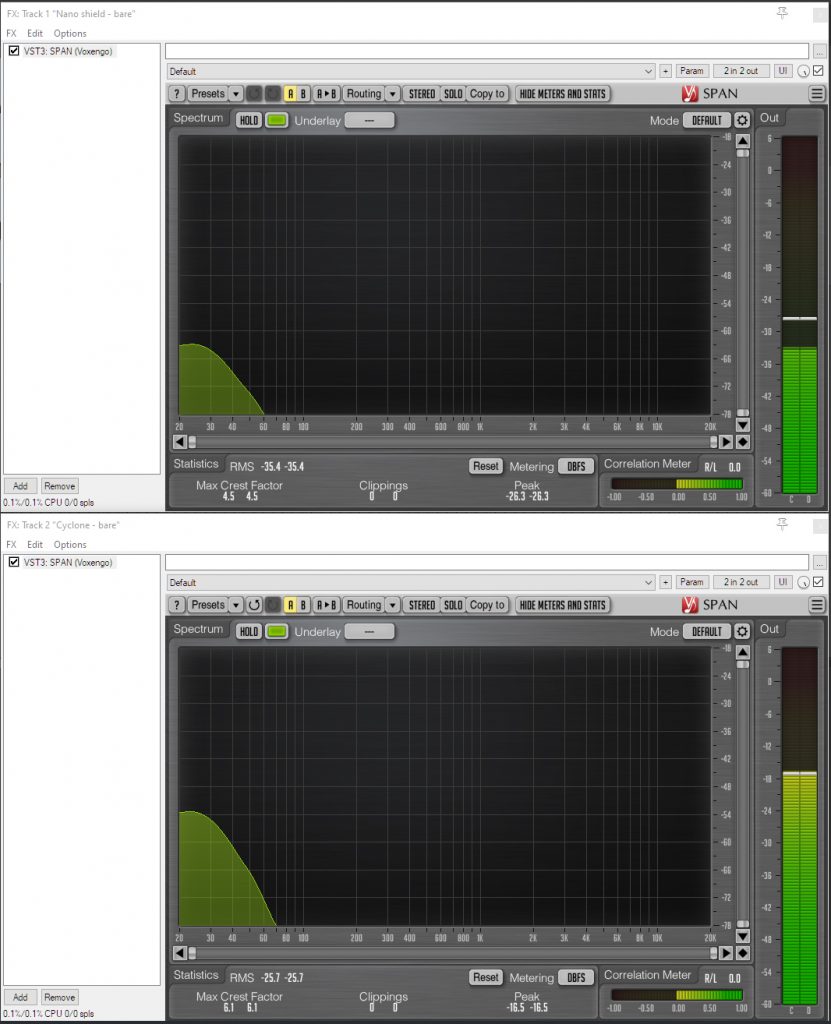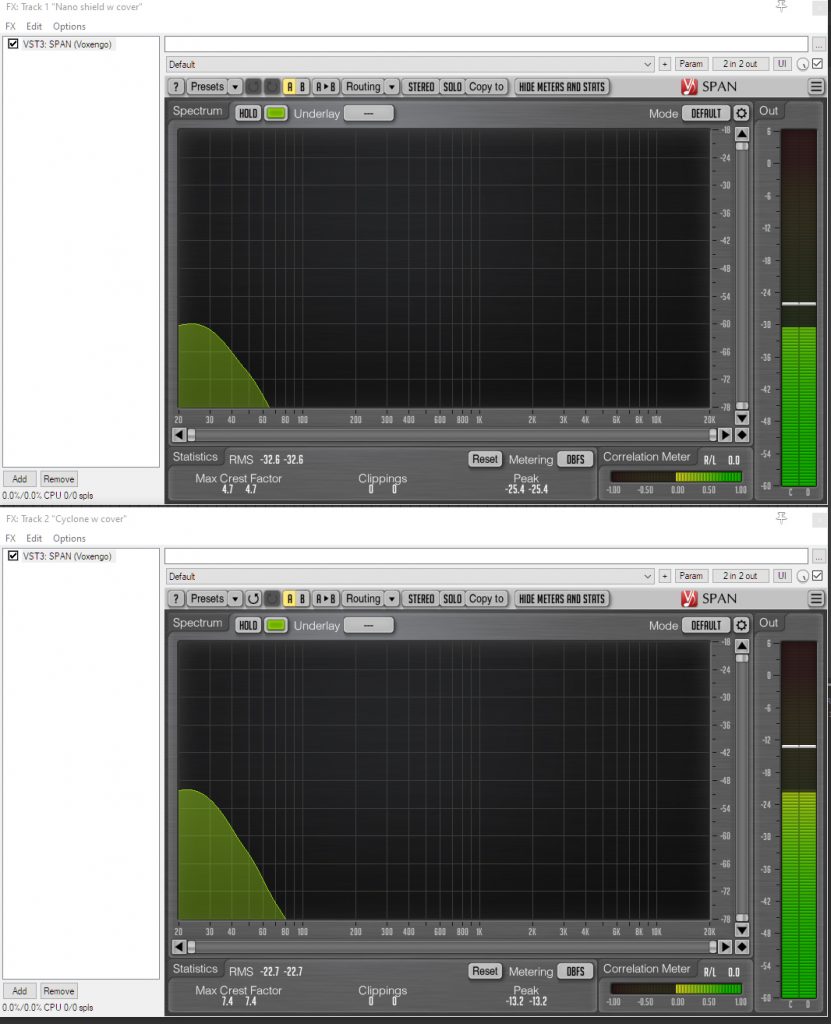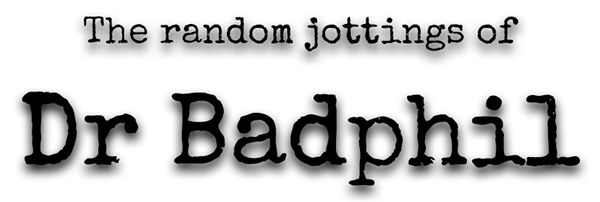Back in October 2022 I posted a blog article on some tests of various windshields I have: these included the Rode blimp, the Rycote Nano Shield and the Rycote Cyclone. The tests were all about performance in wind, but, of course, windshields also vary in terms of their suspensions. This matters to some degree with field recordings with mics on static stands (where vibrations can travel up the stand), but is especially relevant to mics on boom poles, be that for field recording or, more commonly, production sound for film or TV. With the Cyclone just edging the Nano Shield in terms of pure wind performance (and the Rode blimp not actually far behind), I was interested to test whether it also edged its smaller but newer sibling in terms of handling or other transmitted noise: in general use I wasn’t certain as conditions/use never quite match. Does the floating basket design of the Cyclone outweigh the newly designed lyres of the Nano Shield? How crucial is lyre compliance? And I must admit my curiosity was also raised further by some negative rumblings about the handling noise of the Nano Shield, not least on JWSound (a forum for sound production professionals): was I missing something?
So to some tests. First off, I should clarify what models I have tested: the Cyclone is the medium model (a 2021 model), while the Nano Shield model is the NS4-DB, with the improved sock design (using the same 3D-Tex material as used on the Cyclone) and the modified swivel arm for the suspension: both these updates were part of a free kit supplied by Rycote to address a resonance issue that some experienced with the original design (though some sound production professionals have suggested with only partial success). For mics, I used Rycote’s own HC-22 shotgun mic, for the reasons that I have a pair of them, they have an unusually good low-frequency response (useful for highlighting handling noise and exposing the limits of any suspension), and they have low self-noise (8.5 dBA) that helps reduce any distracting hiss when cranking up the gain to hear and measure handling noise. Needless to say, I didn’t use any high-pass filtering to remove the low frequencies for the purposes of these tests, and, of course, I double-checked to see if the mics really did produce the same level output by using a 1kHz test tone. The mics were mounted on a short stereo bar (at 175mm centres) mounted to a Gitzo carbon-fibre boom pole extended to 2.6m (8ft 6″). All tests were done indoors to reduce distraction of environmental noise and to remove wind from the equation.

The Cyclone vs Nano Shield without baskets
First up, I tested the bare suspensions: that is the mics mounted in the windshield suspensions, but without the baskets. With the Cyclone I also removed its chunky C-arm, which is only necessary to support the basket. With the Nano Shield I used blue-lined lyres, which are 62 shore: the 100g weight of the HC-22 shotgun mic is within the range of mics that Rycote suggest should be used with such lyres (ranging up to the 150g MKH60). Using the stiffer green-lined lyres (68 shore) certainly made for more handling noise, so you need to be careful – as always with Rycote suspensions – not to use too stiff a lyre. With the Cyclone, the choice was a bit harder, not least as the shore numbers across the two different lyre types do not equate: for example, given that the Rycote mics are not yet on any compatibility chart, the Rode NTG1 (at 105g almost the same weight as the HC-22) is shown as compatible with 62-shore Nano Shield lyres and 72-shore older style shores (as used in the InVision mounts and in the Cyclone). Initially, I carried out these tests, therefore, with 72-shore lyres in the Cyclone, but the results were poor compared to the Nano Shield, so I swapped out to 62-shore lyres and results for the Cyclone improved. I can see why Rycote recommend 72-shore lyres for such mic weights, however, since manic/very shaky movement of the Cyclone suspension when enclosed (i.e. in later tests: see below) caused the mic to wobble wildly, generating a lot of noise and with obvious danger of hitting the basket. So, to summarize, for all tests I used the recommended and appropriate lyres in the Nano Shield, but for the Cyclone I used a more compliant lyre than recommended, but which gave better performance in all but the most extreme test: in essence, I used the suspensions I would choose for such mics in normal booming for dialogue or field recording.
With the bare suspensions I did four simple tests:
1) holding the boom pole statically in the H position (above head, arms bent nearly ninety degrees at elbows);
2) holding the boom pole in the less flexible but easier crucifix position (i.e. pole behind neck, arms extended horizontally along the pole);
3) holding the boom pole under one arm, which is rather harder, but allows control of mixer; and
4) the H position again, but tapping the pole near its base to test louder noise/stronger vibration transmission along the pole. Here is the sound file arising for the Cyclone (there is a brief silence between each of the four short clips):
And here is the sound file arising from the Nano Shield:
In each case you can hear a distinct difference: the bare Nano Shield suspension is producing significantly less handling noise than the Cyclone. Looking at one of the tests in a spectrum analyzer, as a typical example, we can visualize the differences:

The sound is all very low frequency (below 80Hz ) and peaks around 25Hz, with about 10dB difference between the two in this example. It represents transmitted noise resulting from straining and shaking muscles and, of course, would be less with a fresh, fit and experienced boom pole operator: it is not often than being a weakling and an amateur is an actual advantage, but a worse-case scenario is useful here to highlight differences. There was, as expected, a smaller difference (around 3dB) in the more stable – and muscle-relaxing – crucifix position. Of course, a mic with more bass roll-off would exhibit less handling noise, and even what was recorded in these tests can be removed by use of a high-pass filter.

The Cyclone vs Nano Shield with baskets fitted
To compare the Cyclone and Nano Shield with their respective baskets fitted I expanded the tests (still using the boom pole at 2.6m (8ft 6″) extension) rather, not least as I now had wind protection for the two mics, as follows:
1) holding the boom pole statically in the H position (above head, arms bent nearly ninety degrees at elbows);
2) holding the boom pole in the less flexible but easier crucifix/cruciform position (i.e. pole behind neck, arms extended horizontally along the pole);
3) holding the boom pole under one arm, which is rather harder, but allows control of mixer;
4) the H position again, but tapping the pole near its base to test louder noise/stronger vibration transmission along the pole;
5) cueing (quick rotations of the boom pole as if moving aim of the mic from one speaker/actor to another);
6) boom swinging – 3m/10ft horizontal arcs;
7) moving the mics up down around 1m (3ft) quickly, as if making a sudden adjustment;
8) holding the boom pole in the H position, but shaking it quite significantly (about 25mm/1 inch) up and down, to really push the suspensions; and
9) testing cable slaps (again rather exaggerated) at the base of the boom pole to test transmission of potentially different frequencies;
Here are the sound files arising (again, there is a brief silence between each of the short clips):
As with the sans basket tests, the Nano Shield significantly outperformed the Cyclone in eight of the nine tests. The one exception was that there wasn’t a lot of difference in the outcome of the underarm static boom pole holding; and I repeated the tests several times to check. The most significant difference was with the shaking test, but, as discussed earlier in the post, this is very much the consequence of the 62-shore lyres in the Cyclone allowing major lateral and vertical movement of the shotgun mic with such extreme handling.
Here are the spectrum analyzer screenshots for each of the nine tests:









Conclusions
While my previous tests for wind performance favoured the Cyclone, these tests of the performance of the suspensions showed that the Nano Shield has the edge. This is reassuring in terms of booming: since getting two Nano Shields I have much preferred them at the end of a boom pole (due to smaller size and lower weight) to a Cyclone, but had wondered if I was losing out in some way, especially given the online rumblings. Of course, these tests are limited in range and by the models of windshield and, indeed, mics used: whilst I can be confident that the Nano Shield is a good choice vs the Cyclone for booming with my HC-22 shotgun mics, other sizes of the two windshield types and different mics may produce different results. I’d be rather surprised if results were reversed, but it can’t be ruled out. Why some others are getting problems with the Nano Shields is unclear: evidently, seriously skilled professional boom pole operators may do things with boom poles that are beyond my usage or imagination! In some cases it may be that the upgrade kits haven’t been applied or, indeed, that too stiff lyres are being used for the mic in hand: both would seem unlikely in the hands of an experienced professional, but, in the absence of any details of the exact set-ups causing issues, perhaps one shouldn’t make assumptions. Certainly, I must confess that before these tests I was using the stiffer green-lined lyres (68 shore), rather than the more suited blue-lined lyres (62 shore). For very light mics, it is the red-lined lyres (55 shore) that will be needed, and these are neither supplied with the Nano Shield kits nor, indeed, easily available.




2 Comments
Super helpful. Very generous to take the time to do a thorough test and publish the results in a clear, comprehensible manner. Cheers!
Thanks Kelsey! Cheers, Roland